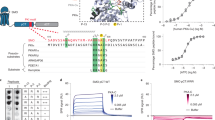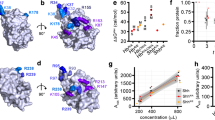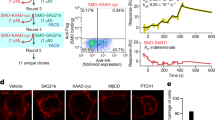Abstract
The Hedgehog (Hh) family of secreted proteins governs cell growth and patterning in animal development1. The Hh signal is transduced by the seven-transmembrane protein Smoothened (Smo); however, the mechanism by which Smo is regulated remains largely unknown. Here we show that protein kinase A (PKA) and casein kinase I (CKI) regulate Smo cell-surface accumulation and activity in response to Hh. Blocking PKA or CKI activity in the Drosophila wing disc prevents Hh-induced Smo accumulation and attenuates pathway activity, whereas increasing PKA activity promotes Smo accumulation and pathway activation. We show that PKA and CKI phosphorylate Smo at several sites, and that phosphorylation-deficient forms of Smo fail to accumulate on the cell surface and are unable to transduce the Hh signal. Conversely, phosphorylation-mimicking Smo variants show constitutive cell-surface expression and signalling activity. Furthermore, we find that the levels of Smo cell-surface expression and activity correlate with its levels of phosphorylation. Our data indicate that Hh induces progressive Smo phosphorylation by PKA and CKI, leading to elevation of Smo cell-surface levels and signalling activity.
This is a preview of subscription content, access via your institution
Access options
Subscribe to this journal
Receive 51 print issues and online access
$199.00 per year
only $3.90 per issue
Buy this article
- Purchase on Springer Link
- Instant access to full article PDF
Prices may be subject to local taxes which are calculated during checkout




Similar content being viewed by others
References
Ingham, P. W. & McMahon, A. P. Hedgehog signaling in animal development: paradigms and principles. Genes Dev. 15, 3059–3087 (2001)
Briscoe, J. & Ericson, J. The specification of neuronal identity by graded Sonic Hedgehog signalling. Semin. Cell Dev. Biol. 10, 353–362 (1999)
Strigini, M. & Cohen, S. M. A Hedgehog activity gradient contributes to AP axial patterning of the Drosophila wing. Development 124, 4697–4705 (1997)
Vervoort, M., Crozatier, M., Valle, D. & Vincent, A. The COE transcription factor Collier is a mediator of short-range Hedgehog-induced patterning of the Drosophila wing. Curr. Biol. 9, 632–639 (1999)
Jiang, J. & Struhl, G. Protein kinase A and Hedgehog signalling in Drosophila limb development. Cell 80, 563–572 (1995)
Li, W., Ohlmeyer, J. T., Lane, M. E. & Kalderon, D. Function of protein kinase A in hedghehog signal transduction and Drosophila imaginal disc development. Cell 80, 553–562 (1995)
Pan, D. & Rubin, G. M. cAMP-dependent protein kinase and hedgehog act antagonistically in regulating decapentaplegic transcription in Drosophila imaginal discs. Cell 80, 543–552 (1995)
Lepage, T., Cohen, S. M., Diaz-Benjumea, F. J. & Parkhurst, S. M. Signal transduction by cAMP-dependent protein kinase A in Drosophila limb patterning. Nature 373, 711–715 (1995)
Wang, G., Wang, B. & Jiang, J. Protein kinase A antagonizes Hedgehog signaling by regulating both the activator and repressor forms of Cubitus interruptus. Genes Dev. 13, 2828–2837 (1999)
Price, M. A. & Kalderon, D. Proteolysis of cubitus interruptus in Drosophila requires phosphorylation by protein kinase A. Development 126, 4331–4339 (1999)
Jia, J. et al. Shaggy/GSK3 antagonizes Hedgehog signalling by regulating Cubitus interruptus. Nature 416, 548–552 (2002)
Price, M. A. & Kalderon, D. Proteolysis of the Hedgehog signaling effector Cubitus interruptus requires phosphorylation by Glycogen Synthase Kinase 3 and Casein Kinase 1. Cell 108, 823–835 (2002)
Jiang, J. Degrading Ci: who is Cul-pable? Genes Dev. 16, 2315–2321 (2002)
Ohlmeyer, J. T. & Kalderon, D. Hedgehog stimulates maturation of Cubitus interruptus into a labile transcriptional activator. Nature 396, 749–753 (1998)
Denef, N., Neubuser, D., Perez, L. & Cohen, S. M. Hedgehog induces opposite changes in turnover and subcellular localization of patched and smoothened. Cell 102, 521–531 (2000)
Ohlmeyer, J. T. & Kalderon, D. Dual pathways for induction of wingless expression by protein kinase A and Hedgehog in Drosophila embryos. Genes Dev. 11, 2250–2258 (1997)
Kalderon, D. & Rubin, G. M. Isolation and characterization of Drosophila cAMP-dependent protein kinase genes. Genes Dev. 2, 1539–1556 (1988)
Alcedo, J., Ayzenzon, M., von Ohlen, T., Noll, M. & Hooper, J. E. The Drosophila smoothened gene encodes a seven-pass membrane protein, a putative receptor for the Hedgehog signal. Cell 86, 221–232 (1996)
van-den-Heuval, M. & Ingham, P. W. smoothened encodes a receptor-like serpentine protein required for hedgehog signalling. Nature 382, 547–551 (1996)
Kemp, B. E. & Pearson, R. B. Protein kinase recognition sequence motifs. Trends Biochem. Sci. 15, 342–346 (1990)
Umphress, J. L., Tuazon, P. T., Chen, C. J. & Traugh, J. A. Determinants on simian virus 40 large T antigen are important for recognition and phosphorylation by casein kinase I. Eur. J. Biochem. 203, 239–243 (1992)
Chijiwa, T. et al. Inhibition of forskolin-induced neurite outgrowth and protein phosphorylation by a newly synthesized selective inhibitor of cyclic AMP-dependent protein kinase, N-[2-(p-bromocinnamylamino)ethyl]-5-isoquinolinesulfonamide (H-89), of PC12D pheochromocytoma cells. J. Biol. Chem. 265, 5267–5272 (1990)
Chijiwa, T., Hagiwara, M. & Hidaka, H. A newly synthesized selective casein kinase I inhibitor, N-(2-aminoethyl)-5-chloroisoquinoline-8-sulfonamide, and affinity purification of casein kinase I from bovine testis. J. Biol. Chem. 264, 4924–4927 (1989)
Lum, L. et al. Identification of Hedgehog pathway components by RNAi in Drosophila cultured cells. Science 299, 2039–2045 (2003)
Kennerdell, J. R. & Carthew, R. W. Heritable gene silencing in Drosophila using double-stranded RNA. Nature Biotechnol. 18, 896–898 (2000)
Zhu, A. J., Zheng, L., Suyama, K. & Scott, M. P. Altered localization of Drosophila Smoothened protein activates Hedgehog signal transduction. Genes Dev. 17, 1240–1252 (2003)
Calleja, M., Moreno, E., Pelaz, S. & Morata, G. Visualization of gene expression in living adult Drosophila. Science 274, 252–255 (1996)
Jia, J., Tong, C. & Jiang, J. Smoothened transduces Hedgehog signal by physically interacting with Costal2/Fused complex through its carboxyl-terminal tail. Genes Dev. 17, 2709–2720 (2003)
Motzny, C. K. & Holmgren, R. The Drosophila cubitus interruptus protein and its role in the wingless and hedgehog signal transduction pathways. Mech. Dev. 52, 137–150 (1995)
Lum, L. et al. Hedgehog signal transduction via Smoothened association with a cytoplasmic complex scaffolded by the atypical kinesin, Costal-2. Mol. Cell 12, 1261–1274 (2003)
Acknowledgements
We thank D. Kalderon, S. Cohen, P. Beachy, R. Holmgren and G. Struhl for reagents, and K. Wharton and H. Kramer for comments. This work was supported by grants from NIH, Leukemia and Lymphoma Society Scholar Program to J.J., who is a Eugene McDermott Endowed Scholar of Biomedical Science at UTSW.
Author information
Authors and Affiliations
Corresponding author
Ethics declarations
Competing interests
The authors declare that they have no competing financial interests.
Supplementary information
Supplementary Figures
This file contains figures and legends for Supplementary Fig. S1 (rescuing smo mutant phenotypes by Smo variants), Fig. S2 (regulation of Smo cell surface accumulation by phosphorylation in S2 cells), Fig. S3 (cell surface accumulation of wild type Smo and SmoSD123 in wing discs) and Fig. S4 (effects of overexpressing phosphorylation deficient forms of Smo on accumulation of wild type Smo in wing discs). (DOC 3122 kb)
Rights and permissions
About this article
Cite this article
Jia, J., Tong, C., Wang, B. et al. Hedgehog signalling activity of Smoothened requires phosphorylation by protein kinase A and casein kinase I. Nature 432, 1045–1050 (2004). https://doi.org/10.1038/nature03179
Received:
Accepted:
Issue Date:
DOI: https://doi.org/10.1038/nature03179
This article is cited by
-
Non-canonical non-genomic morphogen signaling in anucleate platelets: a critical determinant of prothrombotic function in circulation
Cell Communication and Signaling (2024)
-
Hedgehog signalling is involved in acquired resistance to KRASG12C inhibitors in lung cancer cells
Cell Death & Disease (2024)
-
Hedgehog signaling in tissue homeostasis, cancers, and targeted therapies
Signal Transduction and Targeted Therapy (2023)
-
SALL4 is a CRL3REN/KCTD11 substrate that drives Sonic Hedgehog-dependent medulloblastoma
Cell Death & Differentiation (2023)
-
Ihog proteins contribute to integrin-mediated focal adhesions
Science China Life Sciences (2023)
Comments
By submitting a comment you agree to abide by our Terms and Community Guidelines. If you find something abusive or that does not comply with our terms or guidelines please flag it as inappropriate.



